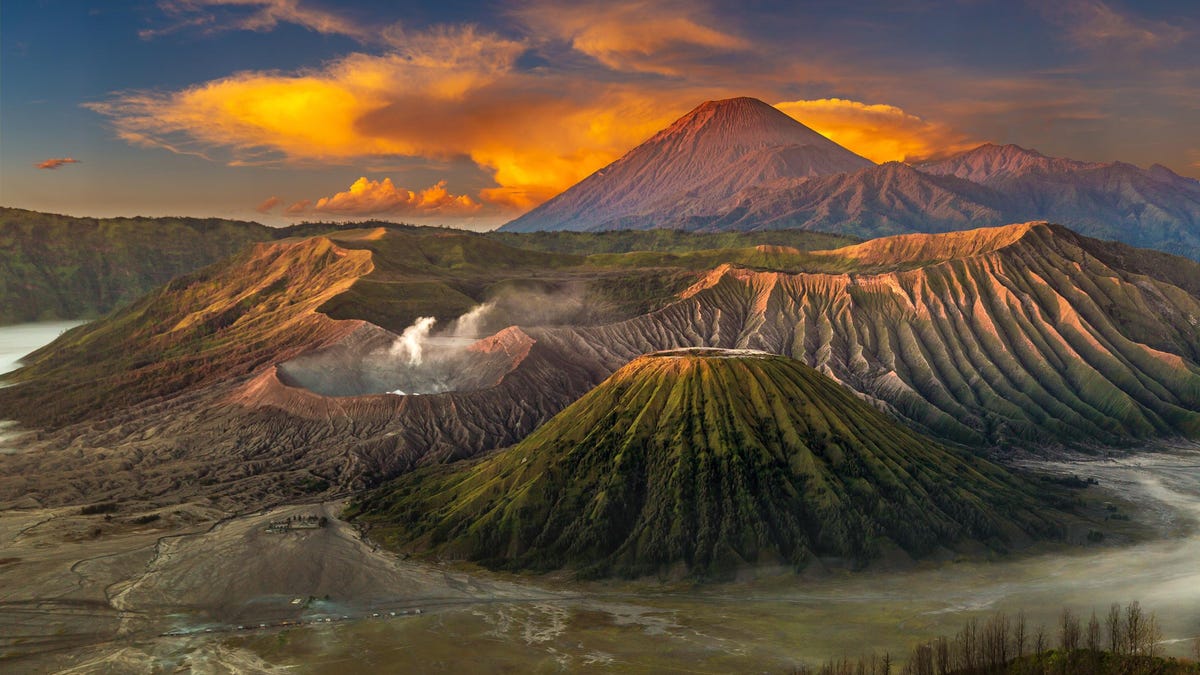The island of Java is home to over half of Indonesia’s overall population.
gettyWith more than 151 million people living within its borders, Java is the most populous island on the entire planet—but in between the sprawling cities and charming villages, there’s no shortage of spectacular natural sites to explore. Verdant rainforests, picturesque beaches, and dense mangrove thickets abound across the island, with no shortage of active volcanoes to discover along the way. As you plan your next trip to Southeast Asia, don’t miss out on this storied piece of the Indonesian archipelago.
Baluran National Park
Baluran National Park was home to Javan tigers until the mid-20th century.
gettyLocated just west of Bali, the 25,000-hectare Baluran National Park showcases the pristine splendor of eastern Java, equipped with a spectacular array of native flora and fauna. Mammal species range from the pint-sized Java mouse-deer to the banteng, a type of wild bovine—both of which are preyed on by the park’s native big cat, the Javan leopard. While Baluran’s forests are home to a wealth of hornbills, the park is best known for its sprawling savannah, where large herds of muntjac can be found grazing while dholes prowl the surrounding area in search of food.
Mount Halimun Salak National Park
Java is home to more than 400 different bird species.
gettyGreater Jakarta may serve as one of the earth’s largest metropolitan areas, but you don’t have to travel too far to find some truly spectacular natural beauty. 100 kilometers southwest of the city, Mount Halimun Salak National Park is an oasis of biodiversity, comprising two massive mountains surrounded by lush rainforest. While humans are drawn to attractions like Cimacan Waterfall and the treetop Canopy Trail bridge, the tangled mass of trees in the park’s interior harbors some of Java’s most vulnerable primate species, with no shortage of West Java gibbons and lutungs crowded into the area.
Goa Jomblang
Java is the fifth largest island in Indonesia.
gettyThe storied city of Yogyakarta is famed for its gorgeous architecture and traditional fine arts scene, and just ninety minutes outside of the city, a particularly fascinating adventure destination exists in the form of Goa Jomblang. This colossal cavern was formed thousands of years ago through erosion, plunging roughly sixty meters into the earth’s crust. During a spelunking expedition into the cave, visitors can spot a wealth of stalactites, stalagmites, and other rock formations across the area, while Goa Jomblang’s renowned sunbeams provide some much-needed illumination. As an added bonus, the forests surrounding the cave are flush with wildlife, offering a vast collection of monkeys and birds to admire.
Bromo Tengger Semeru National Park
Java was created by volcanic activity, with more than forty active volcanoes on the island today.
gettyIndonesia is no stranger to massive mountains, but when it comes to truly awe inspiring peaks, nothing can come close to Bromo Tengger Semeru National Park. The colossal Tengger massif dominates the bulk of the park, consisting of five distinct volcanoes surrounded by a sprawling sand sea—one of the few found in Indonesia. Measuring in at 3,676 meters, Semeru serves as the tallest mountain in the nation, yet neighboring Bromo just might be Java’s most famous natural feature. Renowned for its historic religious significance, this active volcano is a popular hiking destination, with Cemoro Lawang serving as a typical base for a hike to the top.
Karimunjawa National Park
Indonesia is home to roughly 18,000 islands.
gettyWhile the interior of Java is rife with towering volcanoes, lush forests, and majestic native mammals, there’s a treasure trove of natural beauty to be discovered just past the island’s shoreline. On the northern edge of Java, the sprawling Karimunjawa National Park is a haven for all manner of ocean-dwelling flora and fauna, equipped with colorful coral reefs, tangled mangrove forests, and vast beds of seagrass. During a trip to the park, visitors can snorkel along the shoreline in search of dazzling reef fish and sea turtles, while the sandy coast hosts a spectacular array of native birds, with whimbrels, crested terns, and common sandpipers all gracing the area.
